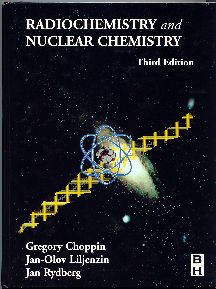
Radiochemistry and Nuclear Chemistry, 3rd Edition
Choppin, Liljenzin, and Rydberg
Butterworth-Heinemann Press, 2002, 709 pages

|
 his textbook on nuclear chemistry, written by
well-known experts in the field, is an excellent general introduction
to the study of radioactivity and its effects on matter. In addition to
providing a solid understanding of radiation, the chapters also have many
useful tidbits of information. The book concentrates
on the physics of nuclear decay, radiation detection, production and separation
of isotopes, and similar topics. There is little information on chemical effects
of radiation such as radiation-induced oxidation or free radical generation. The
topic of radiochemistry is vast, and many of the subjects in various chapters
could be subjects for books by themselves. This forces some of the chapters to
be somewhat superficial.
his textbook on nuclear chemistry, written by
well-known experts in the field, is an excellent general introduction
to the study of radioactivity and its effects on matter. In addition to
providing a solid understanding of radiation, the chapters also have many
useful tidbits of information. The book concentrates
on the physics of nuclear decay, radiation detection, production and separation
of isotopes, and similar topics. There is little information on chemical effects
of radiation such as radiation-induced oxidation or free radical generation. The
topic of radiochemistry is vast, and many of the subjects in various chapters
could be subjects for books by themselves. This forces some of the chapters to
be somewhat superficial.
The vastness of the subject matter means the book is only of limited use as a reference for RSOs or scientists working with radiation. The discussion of dosimetry in the chapter on radiation biology is fairly weak, and there is no discussion of regulations or safety procedures. However, most of the standard information is covered, and the authors take great pains to keep the subject interesting. There is even a discussion of stellar nucleosynthesis, dark matter, and stellar evolution. There is also almost no information on the complex and fascinating nuclear chemistry that occurs in nuclear weapons. If you are looking for design plans for building your own H-bomb, you will have to get them from the Internet like everyone else.
Unfortunately, the print quality in this edition of the book is extremely poor. Many of the illustrations and diagrams are barely legible. For example, on page 362, the labels on the graph showing neutron yield as a function of projectile energy in a particle accelerator are unreadable. The labels on the graph on page 179 showing the radiation yield for oxidation of Fe2+ and Ce4+ as a function of radiation linear energy transfer are also unreadable.
The book has a strong bias toward high-Z and transuranium radioisotopes. In particular, isotopes below thallium-179 are not even listed in their isotope tables. Half-lives of lighter isotopes and isotope decay chains for many isotopes are scattered throughout the book or omitted altogether. Thus, for completeness this book would have to be supplemented by another book such as Table of Isotopes, which costs over $300.
